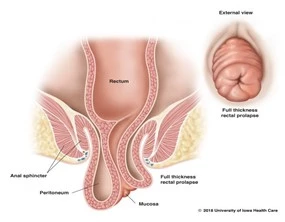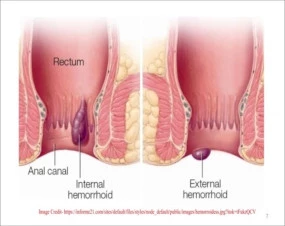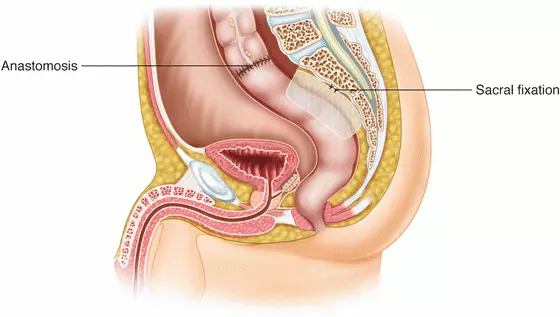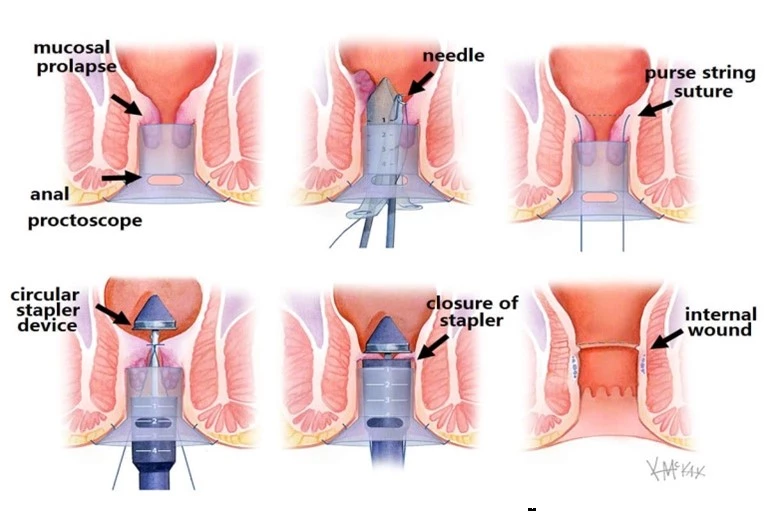
Dr. Rajendra Sonavane
M.S.,F.I.C.S.,F.I.A.G.E.S.,F.I.S.C.P.
Certified training in LASER surgery, Germany & Poland
What is rectal prolapse?


The rectum is the last part of the large intestine. Prolapse means a body part has slipped from its normal position. Thus, when a part of the rectum slides out or folds inside the anus, it is called rectal prolapse. This is a painful condition and can hamper one’s daily routine life. Rectal prolapse can lead to loss of control of the bowel movement and leakage of stools from the rectum and at times difficulty in passing motions.
The incidence of rectal prolapse is higher among older women, but it can occur in men and women of any age. Rectal prolapse is often mistaken to be piles. But, rectal prolapse affects the rectal wall, unlike piles which are an enlargement of the fleshy cushions in the anal canal.
Rectal prolapse may be internal or external. The most common type of external prolapse is when the large intestine, either partially or completely slides out of the anus. In some cases of external prolapse, only the lining of the anus, known as mucosa comes out of the anus. In the case of internal prolapse, the rectum folds inside itself but does not protrude out.

What causes rectal prolapse?
It is common to find elderly women who had multiple vaginal deliveries, with weakened pelvic floor and prolapse of uterus or bladder. These women have higher chance of getting rectal prolapse. Although elderly population is more likely to get inflicted with the disease, any young person can also get it.
The most common causes of rectal prolapse are:
- Constipation or straining during defecation
- Repeated delivery particularly vaginal delivery
- Ageing and weakening of anal muscles
- Chronic diarrhoea
- Chronic coughing
- Sometimes, neurological conditions like multiple sclerosis, injury to lower back or pelvis, lumbar disc disease, spinal injury, etc.
What are the signs and symptoms of rectal prolapse?
Rectal prolapse progresses gradually. In the beginning, a prolapsed rectum will not be visible but may be felt as if something is coming out of the rectum. There could be constipation or bleeding from the anus while passing motions. Gradually, the rectum begins to stick out every time of passing motions. Sometimes, it may go in and other times, it has to be pushed back inside with fingers. Later, if left untreated and the disease progresses, the rectum stays out permanently and feels like a lump protruding out. At this stage, simple activity like sitting also gets painful. Any strain like coughing or sneezing can also bring the rectum out.
Unlike external prolapse, in case of internal prolapse; the rectum does not protrude out. In such cases, the patient experiences a feeling of incomplete defecation as if they have not passed everything out. Many patients may have difficulty in controlling bowel movement, bleeding, discomfort or constipation.
Hence watch out for these signs while passing motions:
- Bulge or red mass like lump outside the anus
- Pain while passing motions
- Leakage of stools
- Bleeding from anus
When do you see the doctor?
If you have any of the above signs and symptoms, you need to consult a doctor. Delay in treatment will aggravate the problem and may lead to permanent problems like incontinence and nerve damage in the anal region. In the advance stage of the disease, there is a chance of getting ulcerations and incarceration in the affected area.
How does your doctor diagnose rectal prolapse?
Doctors at Proctocare clinic will ask for the patient’s medical history and symptoms and then conduct a physical examination. For an accurate diagnosis, further tests may be required, which include Video-proctoscopy, colonoscopy, endo-anal ultrasound and MRI scan.
What are the treatment options available for rectal prolapse?


Depending on the underlying cause of the prolapse and taking into account the patient’s age and general health, various treatments can be offered. If it is in an early stage, lifestyle modifications like dietary changes and pelvic floor exercise to strengthen the pelvic region are recommended. Along with it, laxatives to ease bowel movement are prescribed. Treatment of constipation is a must to prevent further damage. Eventually, an advanced prolapse will need to be operated. If left untreated, complications are possible, for example, strangulation of the rectum leading to gangrene or ulcers.
There are two types of surgeries offered depending on the type and stage of the rectal prolapse. Doctors at Proctocare clinic routinely do either Laparoscopic or Stapler surgery (STARR surgery). In laparoscopic surgery, the protruding rectum is pulled up and restored to its place. While in case of STARR surgery the prolapsed part is restored with the help of two staplers. After surgery, the patient is advised to avoid straining the operated region and physical activities like lifting heavy weights for at least 6 months.